Rosetta spacecraft headed for comet suicide crash
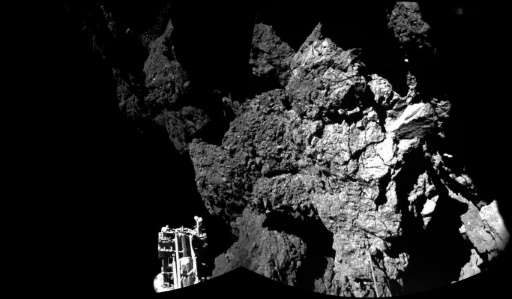
Europe's pioneering spacecraft Rosetta headed for a suicide crash Friday with the comet it has stalked for two years, nearing the end of an audacious quest to unravel the Solar System's mysteries.
Sent by ground controllers on a leisurely, 14-hour freefall, Rosetta launched into a last-gasp spurt of science-gathering on the 19-kilometre (12-mile) journey to its icy comet tomb.
"Next stop #67P!" the European Space Agency (ESA) tweeted, using a shortened version of Comet 67P/Churyumov-Gerasimenko's full name.
It confirmed that the command for Rosetta to exit the galactic wanderer's orbit was received at 2051 GMT Thursday, at a distance of 720 million kilometres (450 million miles) from Earth.
The craft was programmed to terminate its 12-year space odyssey at about 1040 GMT on Friday, joining long-spent robot lander Philae on the comet for a never-ending journey around the Sun.
"We're all very excited," Rosetta project scientist Matt Taylor told AFP at the mission control centre in Darmstadt.
Rosetta's science instruments were primed to sniff the comet's gassy coma, or halo, measure its temperature and gravity, and take pictures from closer than ever before.
"In the final descent, we will get into a region that we have never sampled before. We've never been below two kilometres, and that region is where the coma, the comet atmosphere, becomes alive, it's where it goes from being an ice to a gas," said Taylor.
With the comet zipping through space at a speed of over 14 kilometres (nine miles) per second, Rosetta was programmed to make a "controlled impact" at human walking speed, about 90 cm (35 inches) per second.
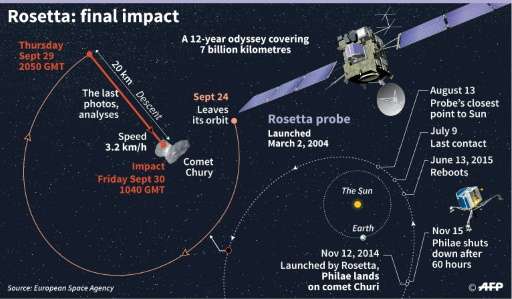
Confirmation of the mission's end is expected in Darmstadt around 1120 GMT when Rosetta's signal, which takes 40 minutes to travel, vanishes from ground controllers' computer screens.
"It's mixed emotions," Taylor said of the impending end.
While it will all be over for mission controllers, scientists will be analysing the information gleaned for "years if not decades" to come.
'Massive puzzle'
"We've only just started to get an understanding of what the data is telling us, putting together the pieces of the puzzle," said Taylor.
"We've got this massive puzzle, all the pieces are everywhere, and we need to put them together."
The first-ever mission to orbit and land on a comet was approved in 1993 to explore the origins and evolution of our Solar System—of which comets are thought to contain primordial material preserved in a dark space deep freeze.
Rosetta and lander probe Philae travelled more than six billion kilometres over 10 years to reach 67P in August 2014.
Philae was released onto the comet surface in November of that year, bouncing several times, then gathering 60 hours of on-site data which it sent home before entering standby mode.
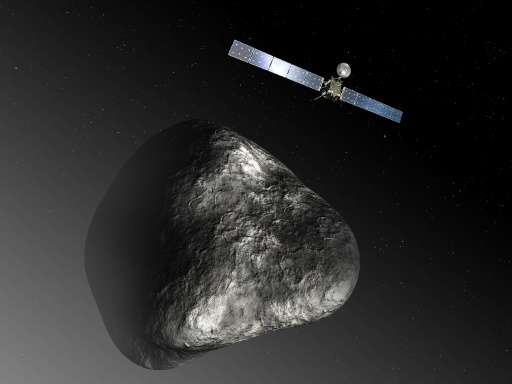
Insights gleaned from the 1.4-billion-euro ($1.5-billion) mission have shown that comets crashing into an early Earth may well have brought amino acids, the building blocks of life.
Comets of 67P's type, however, certainly did not bring water, scientists have concluded.
Rosetta's comet is currently speeding away from the Sun on its near seven-year elongated orbit, which means the craft's solar panels are catching fewer battery-replenishing rays.
Rather than just letting it fade away, scientists opted to end the mission on a high by taking measures from distances too close to risk under usual operating conditions.
Rosetta was never designed to land.
A highlight of the final hours will be a one-off chance to peer into mysterious pits dotting the landscape for hints as to what the comet's interior might look like.
Rosetta was programmed to switch off on impact, to make sure its signals do not interfere with any future space missions.
"After Rosetta has touched down, it will not be possible to collect or return any additional data," the ESA said.
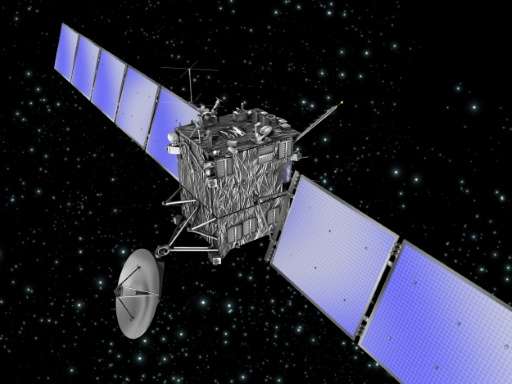
Rosetta's comet adventure in numbers
Europe's ground-breaking quest to unravel the Solar System's mysteries concludes Friday with the Rosetta comet chaser crashlanding onto the cosmic wanderer's rocky surface.
The mission, summarised in numbers:
1: Rosetta became the first spacecraft, in August 2014, to enter the orbit of a comet. In November of that year, it sent down robot lab Philae, which became the first comet lander.
6.5 billion: Kilometres (four billion miles) travelled from Rosetta's launch in March 2004 until it reached Comet 67P/Churyumov-Gerasimenko, aided by gravity boosts on Earth and Mars flybys. By now, the accumulated distance is 7.9 billion km.
12 years, six months, 28 days: Mission duration from launch to end.
786: days Rosetta spent circling 67P, sniffing and tasting its atmosphere and photographing it from all angles.
19: kilometres (11 miles)—the altitude from which Rosetta was set on a collision course with the comet.
14: hours—the duration of Rosetta's freefall.
90: centimetres (35 inches) per second—the speed at which Rosetta is to make a "controlled impact" with the comet.
720 million: kilometres (450 million miles)—Rosetta's distance from Earth when it received its suicide command.
14.2: kilometres (8.7 miles) per second—the speed of the comet, with Rosetta and Philae on deck, zipping around our Sun on a near seven-year elongated orbit.
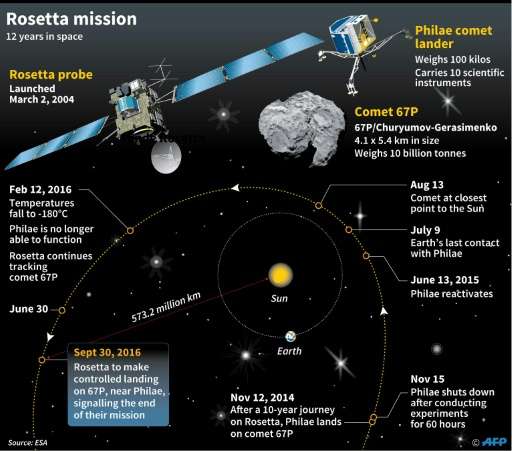
40: minutes—the time it took for signals to travel between mission control in Darmstadt and Rosetta.
11: Science instruments onboard Rosetta, added to another 10 on Philae.
100 kilograms (220 pounds)—Washing machine-sized Philae's weight on Earth, compared to one gram (0.04 ounces) on the low-gravity comet. Rosetta weighs some three tonnes.
1.4 billion: euros ($1.5 billion), the cost of the mission, approved in 1993.
500: Number of scientists and engineers involved in the project.
SOURCE: European Space Agency
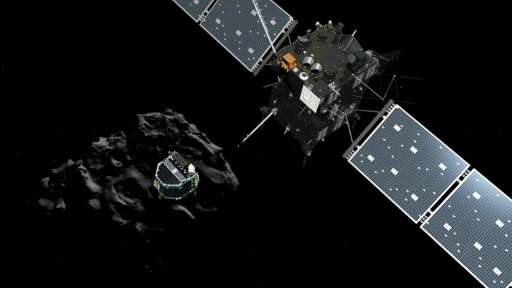
© 2016 AFP




















